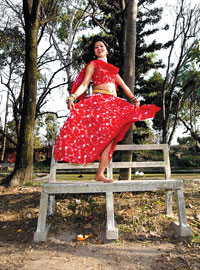|
|
Under the orange spot lights, Rashmi Kharel sways her body gracefully like a flickering candle flame, and her arms curve like ocean swells. It is only when she starts spinning, with her red skirt flaring like a lotus flower, that you realise the stunning performance has been executed with only one leg.
When she was seven years old, a public bus hit her while she was on the way home from school. After being thrown several metres, she collapsed. The driver immediately reversed his vehicle; not to save, but to kill her. Medical bills could build up to an exorbitant amount that a normal salaried worker can't afford. If an accident happens, it costs much less to compensate for death than for injury. In other words, it is cheaper to kill. Although the driver did not succeed, he ran over her right leg, injuring it so badly that it had to be amputated.
It was an ironic blessing that Rashmi was very young when the accident happened. She got over the crying and grieving very quickly, even though adults were still lamenting her misfortune.
After the accident, she had to learn to walk all over again, with crutches made by her father. But she sees the walking aid as a hindrance rather than a help: "my friends would be playing kabaddi and it was impossible for me to play with crutches."
Our second meeting, which was at Bhrikuti Mandap, came one week after her performance. When I arrived outside the National Disabled Rehabilitation Centre, she grinned at me and hugged me like she had known me all her life. Dressed in a colourful white and yellow kurta surwal, Rashmi sat cross-legged on a white plastic chair during the interview. Whenever she's not dancing, she puts on her prosthetic.
The first time Rashmi tried dancing, she couldn't even balance herself. She fell, she cried. But fear got her back on her feet again. "I imagined my life without my parents to take care of me, which I knew would eventually happen," she said. At that point, dancing wasn't simply an interest. It was a test of her independence.
She would secretly memorise the steps whenever her friends danced, and lock herself in her room to practice. At 18, she signed up for a dance competition organised by Patan Campus. "My brother cried when he saw me dancing," she said. Her younger brother, who was a student at the campus at that time, closed his eyes throughout the performance. He was afraid that she would fall.
Today, when Rashmi dances, not only eyes will be wide open, jaws will also follow suit. Her husband fell in love with her after he saw her performing on stage. "It's a love marriage," she said proudly.
The 23-year-old does not feel that the accident made her different from others, but instead, she thinks it had brought her closer to experiencing life. "Life is a struggle" she said, adding that everyone encounters their own set of challenges, and the pain she went through probably isn't unique to her.
She hopes to set up an arts school for the disabled in the near future, so that they too will be given a chance to showcase their talent. The dancer has not only convinced others to see her without being reminded of her disability, but has also proven the power of her will. Just like she said, there is nothing she cannot do - her perseverance and eventual success should stand as an example to anyone.
Rashmi has gone to Cambodia as one of the two representatives from Nepal to participate in a dance competition for the disabled in the Asian region. We wish her all the best!



